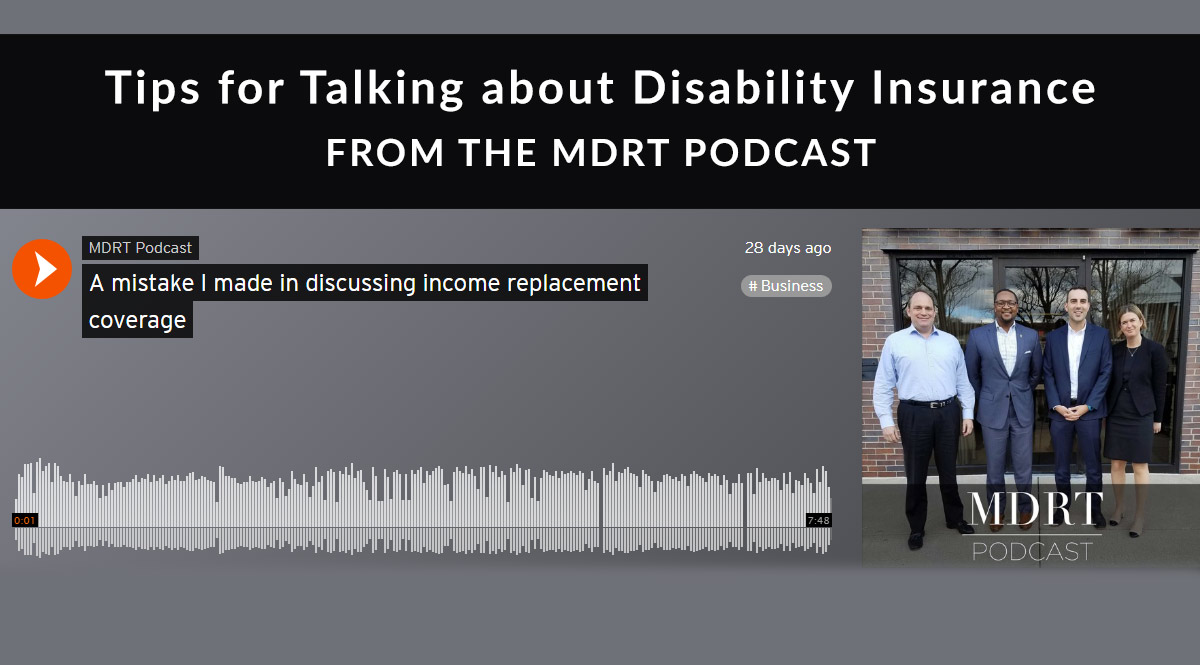
In a recent episode, the MDRT Podcast gathered four producers to give tips for talking about disability insurance and income replacement with clients.
If your client gets sick or hurt and can’t work, what coverage do they have in place to replace their lost income? Not surprisingly, the strategies these panelists have developed over the years will also work when talking about life insurance protection with your prospects.
The four panelists are:
Everett Revere Foxx
Steven Genoff, CFP
Brandon Green, ChFC, CLU
Dana Mitchell, CLU, CFP
Here’s what they learned – and what you can take away. Get our recap below or listen to the full podcast episode here:
Common Mistakes
- The first mistake new agents usually make? Presenting top-of-the-line coverage as the only option. A better solution is to provide options more sensitive to every budget. Then, work to build coverage with additional features or riders.
- A mistake even experienced agents often make? When a client says they already have disability insurance, but the agent doesn’t ask for details. In many cases, people don’t understand what they have. They may have less coverage than they think. Some clients also feel that the name of the insurance—disability income insurance—implies they have full protection. For example, Dana Mitchell shared an experience she had with a client. She asked her client about income replacement coverage. The client said yes, she had coverage, and shared her premium amount. Mitchell knew this was way off what it should have been, so she asked for more information. When the client shared her plan details, Mitchell discovered the plan was for AD&D, not disability. It turned out this client had no income protection at all.
- Are clients reluctant to share benefit plan or coverage details? Not usually, according to panel participants. If they can’t share their employee benefits package (or don’t want to), you can still ask if they’re willing to look up a few numbers. You don’t need to see the documents themselves if a client is willing to share their coverage amount, waiting period, benefit limit, or similar plan details. According to Mitchell, the people she’s worked with have been happy to go over these details with someone who knows what it means.
Increasing Conversions and Working with Millennials
- The best way to increase sales? Ask open-ended questions instead of yes/no questions. According to Steven Genoff, you’re shutting down the conversation if you only ask yes/no questions. Instead, ask questions like “how” or “why” to increase your engagement opportunities. When he’s asking the right questions, Genoff says he can see the client selling on his behalf because he’s creating the right hypothetical situations.
- The best way to start the conversation? Most of Genoff's clients are in their mid-late 20s. They expect to work to age 65 or 70. But often their employer-sponsored disability coverage only has a 2-year duration. That won’t cover the remaining years they intended to work if they get sick or injured. Once he sets up this situation, he asks if they have a gap. When he gets a nod or a “yes” from the client, he knows he’s making progress. Then he follows up with open-ended questions to increase the engagement.
- How can you interest millennials in income replacement coverage? According to the panel, you should cover the topics they’re most interested in first. For example, your millennial clients want to build wealth, buy their first home, or put money into the stock market. So you have to have that conversation first. Then you can look at their overall risk profile and bring up income replacement. In many cases, they thank you for bringing it up because it’s something they wouldn’t have thought of on their own.
Using Referrals and Reviews to Build Your Book of Business
- How can you leverage one client to find other prospects? When you’ve educated someone on the limits of their employer-sponsored coverage, you know there are others with the same coverage. They need the same info you just gave your client. You can use that in your marketing and prospecting. Also, depending on your client’s specific industry, word of mouth may help you out, too. Genoff reports that he often works with medical professionals. If they get good advice, they’ll tell their colleagues.
- How can you use the review process to strengthen relationships? By constantly reviewing a client’s disability income insurance policy. You probably already do annual reviews for their life insurance coverage, but how often do you also review their disability coverage? According to Mitchell, she didn’t realize how quickly people’s income situations change. Instead of reviewing disability every 10 years, it may only be 2 or 3 years before their needs change.
That's our quick round-up of tips for talking about disability insurance.
You can listen to more episodes of MDRT podcast here on SoundCloud.
